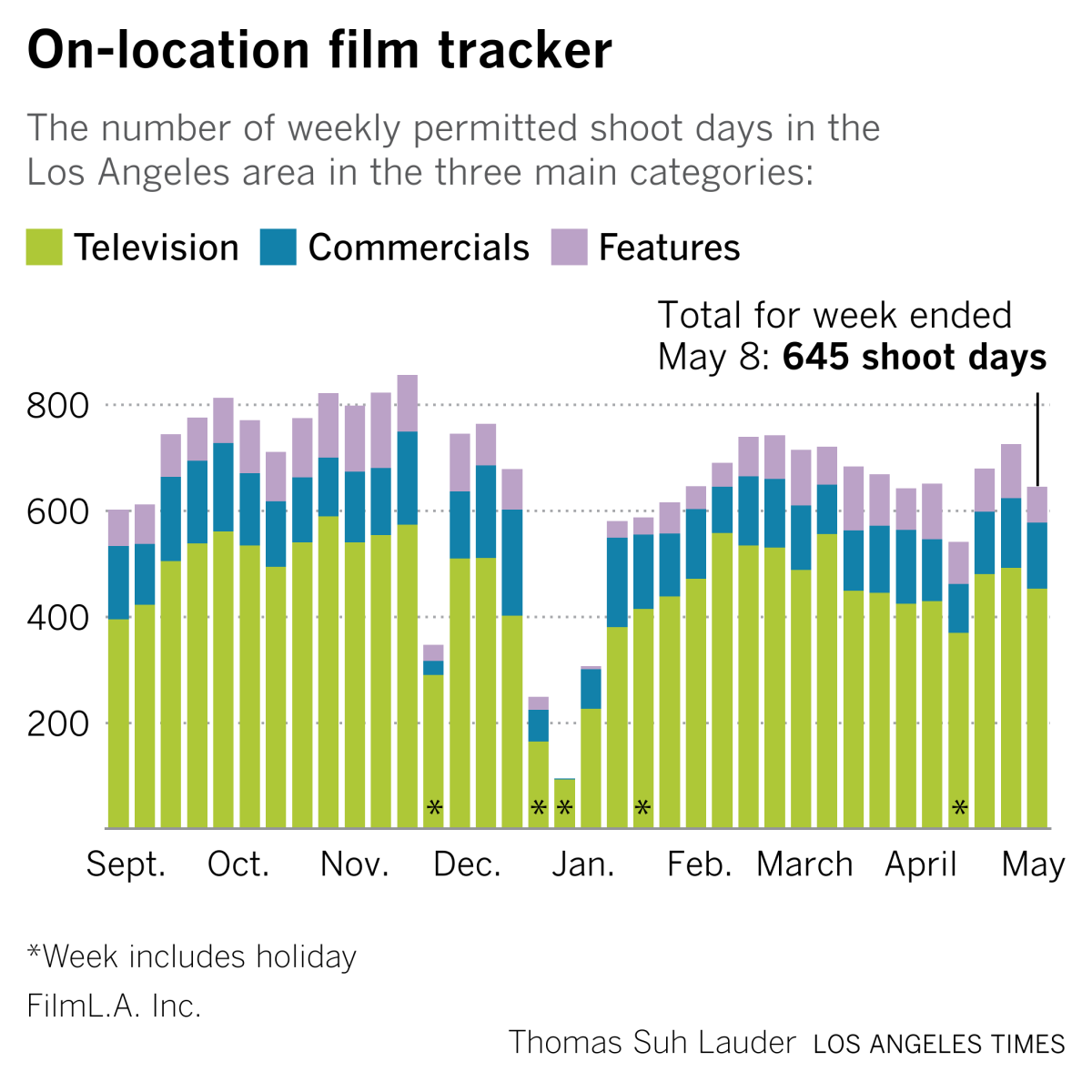With ‘Doctor Strange’ and ‘Everything Everywhere,’ Hollywood multiverses tap our mad moment

- Share via
First, some housekeeping: My colleagues on Thursday are hosting a live chat about the Johnny Depp-Amber Heard trial, featuring Emily D. Baker, the former deputy district attorney who has been tracking the defamation case. Here’s the link to the Twitter Spaces event. I hope many of you can join.
And now, the May 10 edition of the Wide Shot newsletter on the business of entertainment. Sign up here to get it in your inbox.
Given the chaotic state of our own universe, with inflation, war in Europe and Washington shenanigans, perhaps it’s no surprise that what’s appealing most to audiences right now is the idea of countless alternative worlds.
The latest example is Walt Disney Co.’s “Doctor Strange in the Multiverse of Madness,” the new Marvel movie dominating the box office charts, as Marvel movies tend to do, with its $187-million domestic opening weekend. Directed by Sam Raimi, Benedict Cumberbatch’s superhero sorcerer portals to a multitude of realities, adding more spinning force to the already dizzying plot of Marvel’s increasingly interdimensional franchise.
Hollywood always takes viewers to other worlds. But this goes beyond mere escapism in a way that feels specific to today.
Commercially speaking, the “Doctor Strange” sequel (if that’s the right term, given the cat’s cradle of temporality going on here) is Marvel’s follow-up to “Spider-Man: No Way Home,” which used the multiverse concept to bring back Spider-Men of the past, wrapping the audience in futuristic nostalgia and grossing nearly $1.9 billion worldwide in the process.
More key to the plot, though, the new film is equally a direct sequel to the Disney+ series “WandaVision,” in which Elizabeth Olsen’s protagonist Wanda Maximoff, a.k.a. the Scarlet Witch, created her own false sitcom bubble to cope with her trauma and loss, and now sets her sights on conquering the multiverse.
To which this reporter asks, are we OK?
Hollywood tends to say something about the times through even its most populist product, intentionally or not, whether in the paranoid conspiracy thrillers of the 1970s or the over-the-top macho action of the 1980s. Today’s audiences, inundated with apocalyptic messaging on cable news and social media, may be uniquely willing to imagine worlds within worlds that could have gone differently in incalculably varied ways.
They’re also accustomed to the feeling of having to parse what’s true in a world where we’re confronted with competing versions of reality every day. In Disney+’s latest Marvel show, “Moon Knight,” Oscar Isaac’s protagonist suffers from dissociative identity disorder. In Apple TV+’s dystopian sci-fi drama “Severance,” people choose to literally bifurcate their consciousness to avoid the uncomfortable aspects of their lives.
Even the indie darling of the moment is one that takes the multiverse concept to frenetic extremes. Daniel Scheinert and Daniel Kwan’s “Everything Everywhere All at Once,” from A24, posits that every decision Michelle Yeoh’s character makes (really, every choice every human has ever made), however slight, has created a separate branching reality. The film has become an unlikely hit, grossing more than $40 million at the North American box office in two months.
The Daniels’ quirky version of a comic book movie dives into the deep end of space-time chaos, while offering a Kurt Vonnegut-style rebuttal to nihilism and an appeal to love and kindness as the only way to make sense of the madness. There’s something comforting about the notion that you might be able to access one of those universes, even one where people have hot dogs for fingers.
Characters have been traveling through time and space to correct historical and personal errors for decades. The core idea and plot of “Back to the Future” arguably is as weird as anything in Marvel’s multiverse, including “Loki,” which introduces a bureaucratic organization of time cops to the MCU and features an alligator version of the trickster god. Marty McFly, though, I must say, may have met his match in Yeoh’s underachieving laundromat owner.
The embrace of the multiverse also satisfies studio business imperatives, offering Hollywood a new cheat code of sorts. It allows the studios to expand their franchises in surprising directions without having to give them the full shake of the Etch-A-Sketch whenever a reboot is required.
Five years ago, if a studio wanted a new “Spider-Man” trilogy, the executives and filmmakers had to basically start from scratch. You had to toss out the old to bring in the new. Not anymore. With “Spider-Man: Into the Spider-Verse,” Sony showed that the more Spider-People they put into the same movie, the better. Audiences accepted a world in which Peter Parker, Miles Morales, Gwen Stacy and Spider-Ham could team up.
The industry has taken notice. Warner Bros.’ DC film unit seems to be aping Marvel again by doing its own version of crisscrossing realities. With its footage for “The Flash,” revealed at CinemaCon, the studio reintroduced Michael Keaton in the Batsuit, 30 years after he last played the Caped Crusader in Tim Burton’s “Batman Returns.” Think of it as the modern version of “Star Trek: Generations.”
Speaking of alternate realities, one of the richest people on Earth, Meta Platforms chief Mark Zuckerberg, wants to build a metaverse, a virtual world where people buy virtual clothes, attend virtual parties and work in virtual offices. Companies in entertainment, most notably Disney, are coming up with game plans for how they might participate in the virtual worlds. If viewers want an escape from this planet, though, they don’t have to put on a VR headset. They can just watch Marvel.
Stuff we wrote

— Netflix’s stumbles cause rivals to rethink streaming. “While streaming may not be the shiniest object on the stock market anymore, there is no putting the genie back in the bottle,” my colleagues Stephen Battaglio and Wendy Lee wrote in their analysis of what Netflix’s bad quarter means for the rest of the business.
— Pulitzer day! Congratulations to my colleague Marcus Yam, who on Monday won the 2022 Pulitzer Prize for breaking news photography for his poignant and searing pictures of last summer’s fall of Kabul, Afghanistan, to Taliban fighters. Additionally, The Times was named a finalist in the breaking-news category for its coverage of the accidental shooting death of cinematographer Halyna Hutchins on the set of “Rust.”
— ICYMI for Mother’s Day. How CBS journalist and organ-donating mom Catherine Herridge finds purpose in military vet reporting.
— CNBC’s “The Profit” and host Marcus Lemonis are at the center of a $30-million fraud claim. Anousha Sakoui on the latest in a dispute where the trustee of a small company that went bust after appearing on the show has joined other companies in suing NBC and a company partly owned by Lemonis.
— More headlines: MSNBC’s “Meet the Press Daily” with Chuck Todd will move to streaming channel NBC News NOW. A Directors Guild TV study shows diversity gains during pandemic, but not for Latino, Asian filmmakers. Disney-Florida fallout: Local taxpayers sue DeSantis for axing company’s special tax status. “League of Legends” creator Riot Games’ L.A. home is cooler than where you work.
Here’s this week’s Los Angeles production chart, featuring data from FilmLA.

Number of the week

Amazon on April 28 broke down the financial details of its deal to purchase MGM Holdings Inc. (a.k.a. MGM Studios), and one number stood out. The company said MGM’s library of movies and TV shows was valued at $3.4 billion. But wait, you might be saying. Didn’t Amazon pay, like $8.5 billion for MGM, the storied home of James Bond and Rocky?
Here’s the breakdown, according to a short paragraph in Amazon’s filing.
Amazon paid $6.1 billion in cash to acquire MGM and assumed $2.5 billion in debt, which it paid off right away after closing the deal. In addition to the $3.4 billion for MGM’s “video content,” Amazon ascribed $4.9 billion in “goodwill” to the business, where “goodwill” typically serves as a catchall term for intangible assets, like a company’s brand name, executive team and perhaps talent relations.
The $3.4-billion valuation for the library wasn’t terribly surprising to those who’ve studied MGM’s assets and determined that much of the opportunity for reboots and sequels has already been picked over and many of the more lucrative rights have already been committed.
Where the “goodwill” comes from remains to be seen. MGM’s motion picture group chairman Michael De Luca and film president Pamela Abdy resigned from the company in April, leaving Amazon Prime and Amazon Studios head Mike Hopkins to either replace them or figure out some other structure. Amazon has said it is playing a longer game with its MGM purchase, as it looks to, on one hand, use the company to enhance its digital offering, and on the other, grow its theatrical output.
Recommended reading...
— Charles Bethea on the mystery of the Atlanta film set heists. (New Yorker)
— Joshua Robinson on Formula One’s Netflix-fueled resurgence. (Wall Street Journal)
— Olga Khazan on how to change your mind about COVID-19. (The Atlantic)
— Ryan Mac, Cade Metz and Kate Conger on Twitter and Elon Musk’s tendency to wing it. (New York Times)
— Josh Sisco on sinking morale at Lina Khan’s FTC. (The Information)
— Georgia Wells, Yoree Koh and Salvador Rodriguez on TikTok’s relentless workplace culture. (WSJ)
— Borys Kit on Justin Lin’s furious “Fast 10” exit. (Hollywood Reporter)
Finally ... something fun
This is my favorite thing on the internet right now, a Twitter account dedicated to the most bizarre musical instruments ever created. The account, called Musical Instruments With Chaotic Auras, posts photos of six-necked guitars, French horn urinals and oddly shaped violas.
I connected with this account instantly because its profile avatar is a picture of an Otamatone, a gloriously silly Japanese synthesizer with a nasal timbre that is played with one finger and is almost impossible to play in tune. I’ll give the Otamatone this: It has personality. More on that next week...
Inside the business of entertainment
The Wide Shot brings you news, analysis and insights on everything from streaming wars to production — and what it all means for the future.
You may occasionally receive promotional content from the Los Angeles Times.




